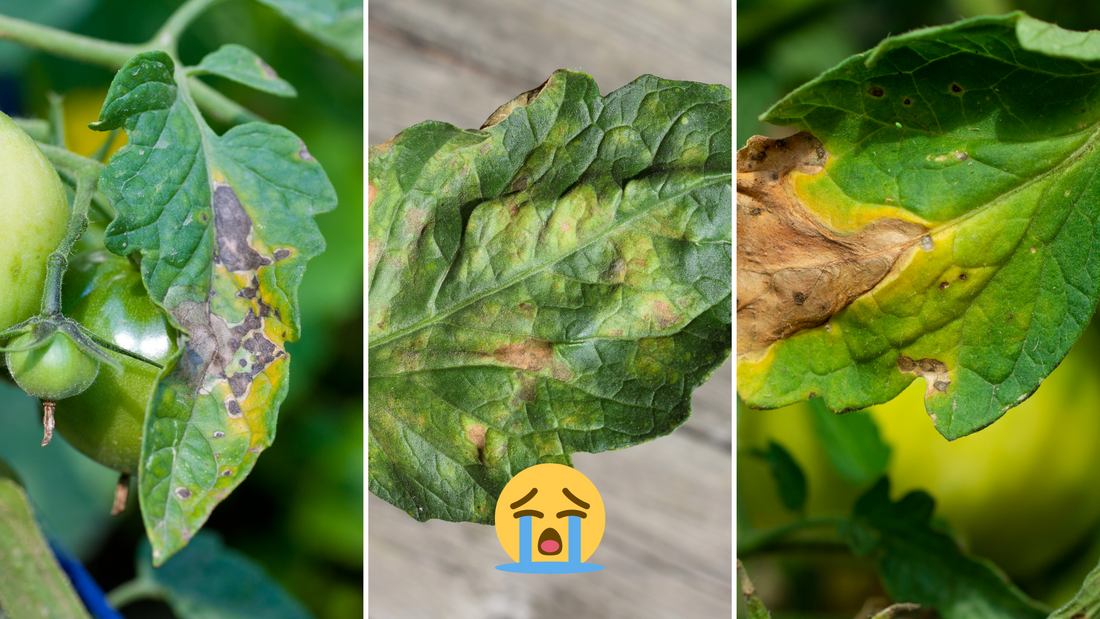The weather has taken a surprisingly wet turn in many parts of Australia this summer and whilst it’s kept many gardens looking green deep into summer. The wet weather can also fungal problems for tomato plants.
Tomatoes are a beloved garden staple, celebrated for their versatility and flavour. However, their susceptibility to various diseases, particularly those exacerbated by wet weather, can be a challenge for growers. Wet weather often creates the perfect environment for pathogens to thrive, leading to issues like fungal infections and blights. Here’s a quick guide on how to manage tomato diseases caused by excessive moisture.
- Understand the Common Diseases:
Before diving into management strategies, it's crucial to identify the diseases commonly associated with wet conditions:
Early Blight (Alternaria solani): Characterized by dark, concentric rings on lower leaves, early blight can cause defoliation and reduce yield. This fungus resides in plant debris in the soil, once spring arrives spores are produced and the rain will often help the spores spread to new plants.
Late Blight (Phytophthora infestans): This aggressive disease manifests as water-soaked lesions on leaves, often turning dark with a fuzzy white growth under humid conditions. This disease tends to occur later in the season when the weather cools and plants are wet.
Septoria Leaf Spot (Septoria lycopersici): Identified by small, circular spots with dark borders and tan or gray centers on the lower leaves. This fungus also spreads in a similar manner to Early Blight.
- Cultural Practices:
Spacing: Whilst it’s inviting to fill your garden with as many tomato plants as possible. Crowded plants take longer to dry and having leaves wet for long periods just creates an environment perfect for fungal infections.
Proper spacing promote air circulation. This reduces humidity around the plants, making it less favourable for disease development. For Indeterminates, give at least 60cm between plants. Dwarf tomatoes 50cm, and Micro tomatoes can manage with 30cm spacing between plants.
Pruning: As your plant develops it is good practice to remove all lower branches so that there are no leaves within 30cm of the ground. Fungal diseases are mostly caused by spores travelling from the soil to the leaves of your plant. Removing leaves close to the soil make this process a lot less likely.
Watering: Water at the base of plants in the early part of the day. Consider drip irrigation or soaker hoses to keep foliage dry. Don’t overhead water as this will wet the leaves and encourage more disease.
Mulching: At Seeds of Plenty we religiously mulch all our beds and planter bags. Mulch is not only a great way to keep water in the soil it also acts as a barrier to prevent water splashing soil on to leaves. Mulch will often break down over the season, so it’s often worth topping it up mid season.
- Sanitation:
Remove Infected Material: Regularly inspect plants and promptly remove any infected or yellowing leaves. Dispose of them away from the garden to prevent disease spread. If a plant is badly infected you can remove up to half the leaves, but any worse you may need to pull the plant.
Rotate Crops: If you can, avoid planting tomatoes in the same location year after year. A 3-4 year rotation can help break disease cycles as pathogens can overwinter in the soil.
If like us you can’t rotate your crops each year don’t despair. Just make sure you mulch very thickly to reduce the risk of spores travelling from the soil to your plants.
Clean Tools: Disinfect gardening tools with a 10% bleach solution or rubbing alcohol after each use, especially if they come into contact with diseased plants.
- Fungicides:
In severe cases, especially when diseases are recurrent or widespread, fungicides can be employed. Always read and follow the label instructions carefully. Organic options like copper-based fungicides can offer some control, but regular applications may be necessary during prolonged wet periods.
- Monitor Weather Conditions:
Stay informed about weather forecasts. If prolonged wet weather is predicted, be extra vigilant with disease management practices and consider preventive fungicide applications.
Conclusion:
While wet weather can pose challenges for tomato growers, proactive management strategies can help mitigate disease risks. By understanding common diseases, adopting cultural practices, maintaining good sanitation, and using appropriate controls when necessary, you can enjoy a bountiful tomato harvest despite the rain. Remember, a healthy tomato plant is better equipped to fend off diseases, so prioritize overall plant health through proper nutrition and care.

